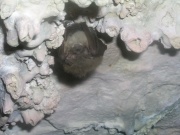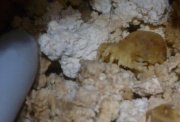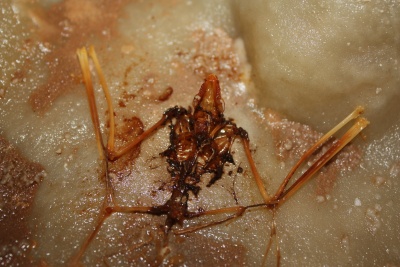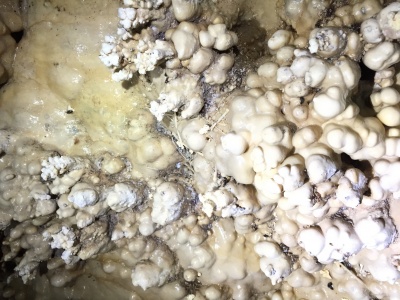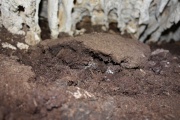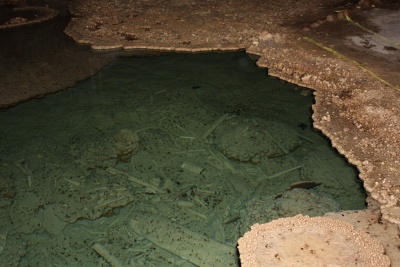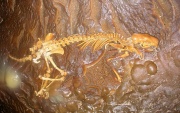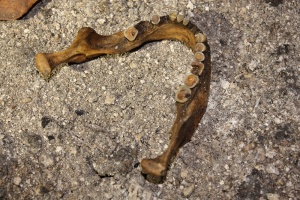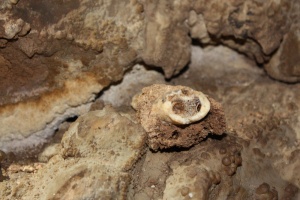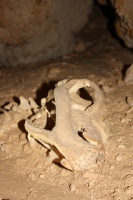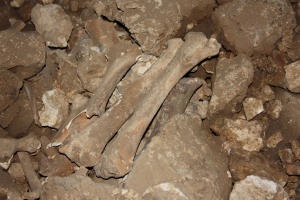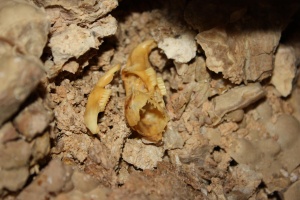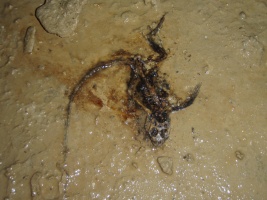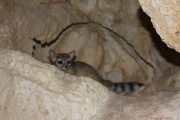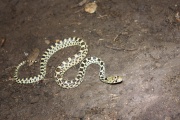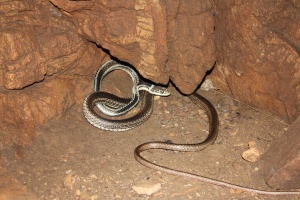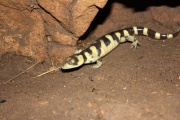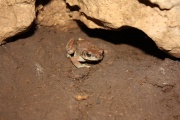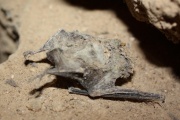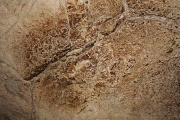Vertebrate (Inventory)
From LagWiki
Bat
The Bat field of the Vertebrate section should be used to record any observation of living bats.
Some caves are habitats for bats. If present, they can be found almost anywhere in the cave from the entrance to deep within. Bats may occupy the cave seasonally (hibernation or maternity) or remain year round. Bats may be observed singly or in a group. They may be resting or flying. Indications that bats may be present include guano on the cave floor, in pools or on formations, and/or stains or scratches on the ceiling. It is highly unusual to find a bat on the floor and is an indication that something may be wrong. Do not disturb any bats observed.
See also
Bat Bones
The Bat Bones field should be used to record any observances of bat bones.
Bat bones can be found primarily on the floor. Bat bones are very fine, fragile, and, except for the skull, needle-like. They can accumulate or be scattered. They may be on the surface or mixed into sediments and soils. They can be found clinging in popcorn or other rough surfaces but they will mostly be found on the floor and usually near a wall. Often the skulls may not be present or be much harder to locate. The skulls are small, about the size of a marble and very delicate. Sometimes, a complete bat skeleton is found intact and may be partially encased and preserved in calcite. Care should be taken not to disturb or step on any bat bones found.
Look carefully along the floor, on shelves or ledges and especially near walls for the fine bones. Seeing them may require a hands-and-knees examination. If rough speleothems are in the area such as popcorn, be sure to examine it for bones which may have been caught by it. And, if a significant guano deposit is found, it is likely to contain bones so examine it. If there is any indication that bats were once in the area, it is likely that bones are around, look for them.
See also
Bat Bones, Vertebrate
Bat bones scattered among Popcorn |
Bat Guano
The Bat Guano field should be used to record any stations which exhibit bat guano.
Bat guano is the excrement left behind by bats. It can be found on the cave floor, on formations, or in pools. It can be a sprinkling of small, dark pellets or, with the passage of time, be piles that are many feet deep. Guano may be old and historic or fresh and young. It could be dry and powdery or wet. Any recognized bat guano should be recorded.
It can be under, over or layered with flowstone and other secondary deposits.
If a significant accumulation is found, examine the ceiling above for bats and bat stains. Historic piles of guano often contain bat bones.
See also
References
- unknown (1997) Geology of Carlsbad Caverns Class - 1997 Memorial Day Expedition p 2
Bat Guano, Vertebrate
Bat Scratches
The Bat Scratches field should be used to record stations where noticeable scratch marks left by bats are found.
Claw and scratch marks may be observed indicating that a bat may have roosted or rested there. These marks are rare but may be found on soft materials like gypsum or corrosion residue. Look for them if there are any signs that bats may have been in the area such as guano or bones. If stains are observed (usually on the ceiling) these should be inventoried as other.
See also
Bones
The Bones field of the Vertebrate section should be used to record any stations which exhibit bones except bat bones.
Many types of bones of vertebrates can be found in caves from small animals such as salamanders, fish, birds, snakes and mice to larger animals such as Ring-tailed Cats, porcupines, and skunks to very large animals such as cows, goats and deer and even humans. It is not necessary to identify the type of animal which left the bones except to confirm that they are probably not bat bones which have their own inventory field.
Complete or almost complete skeletons are possible but bones are usually scattered and skeletons are often incomplete. Bones can be obscured by secondary formations such as calcite and sediments. Bones found in caves may be very old, even prehistoric or relatively young.
If any bones are found which appear to be human or prehistoric, that would be a good time for a photograph and a note on the inventory form.
See also
Bones, Vertebrate
Mammals
The Mammals field of the Vertebrate section should be used to record any observation of mammals except bats.
Several types of mammals can be found in Guadalupe Mountains caves besides bats. Ringtail Cats; small rodents like mice or rats; porcupines; skunks; deer; goats; and others may be found in caves in the Guadalupes from time to time. Most often they will be observed near an entrance; but, ringtails can travel quite deeply into the cave. It is rare to see a mammal in a cave as they are usually elusive, so observe carefully.
See also
Reptiles
The Reptiles field of the Vertebrate section should be used to record any observations of reptiles.
The most common reptiles in caves of the Guadalupes are snakes and occasionally lizards.
Amphibians such as frogs and salamanders should be recorded as "other".
Reptiles, Vertebrate
Birds
The Birds subsection of the Vertebrate section is used to record the observation of birds. The general classification is indicated in the specific field.
Fields
other
The other field of the Vertebrate section should be used to record any vertebrate items for which no other specific field exists on the form.
When listing a station in the other field, a description of the item should be included alongside the station.
Amphibians
Though reptiles have their own field on the form, amphibians do not and should be recorded as "other".
Salamanders
Salamanders are often found in caves but are rare in the Guadalupes and no true cave adapted species are known there, yet; but, there are a few caves where salamanders can be found in the Guads.Frogs
Frogs found in caves are usually in damp locations and usually near an entrance of some kind with good access to food as they are not usually cave adapted.
Bat mummies
Bat mummies are the dehydrated remains of bats with skin intact. There is no separate field on the form for bat mummies so they should be inventoried as other. Bat mummies can be found on the floor or even still clinging to a wall or speleothem. Bat mummies are sometimes found covered with a growth which is usually a greenish color but could be several other colors making them hard to identify as bats. The color from this growth may remain long after the mummy is dehydrated.
Bat stains
A common sign left by bats are stains on the ceiling indicating that bats used that location for roosting. These stains are from the oils and dirt left by the bats. Claw marks on soft formations are more rarely observed and have their own inventory field. An accumulation of guano may be present below a location with bat stains.
Example
other: FF16 (Bat mummy)
See also
